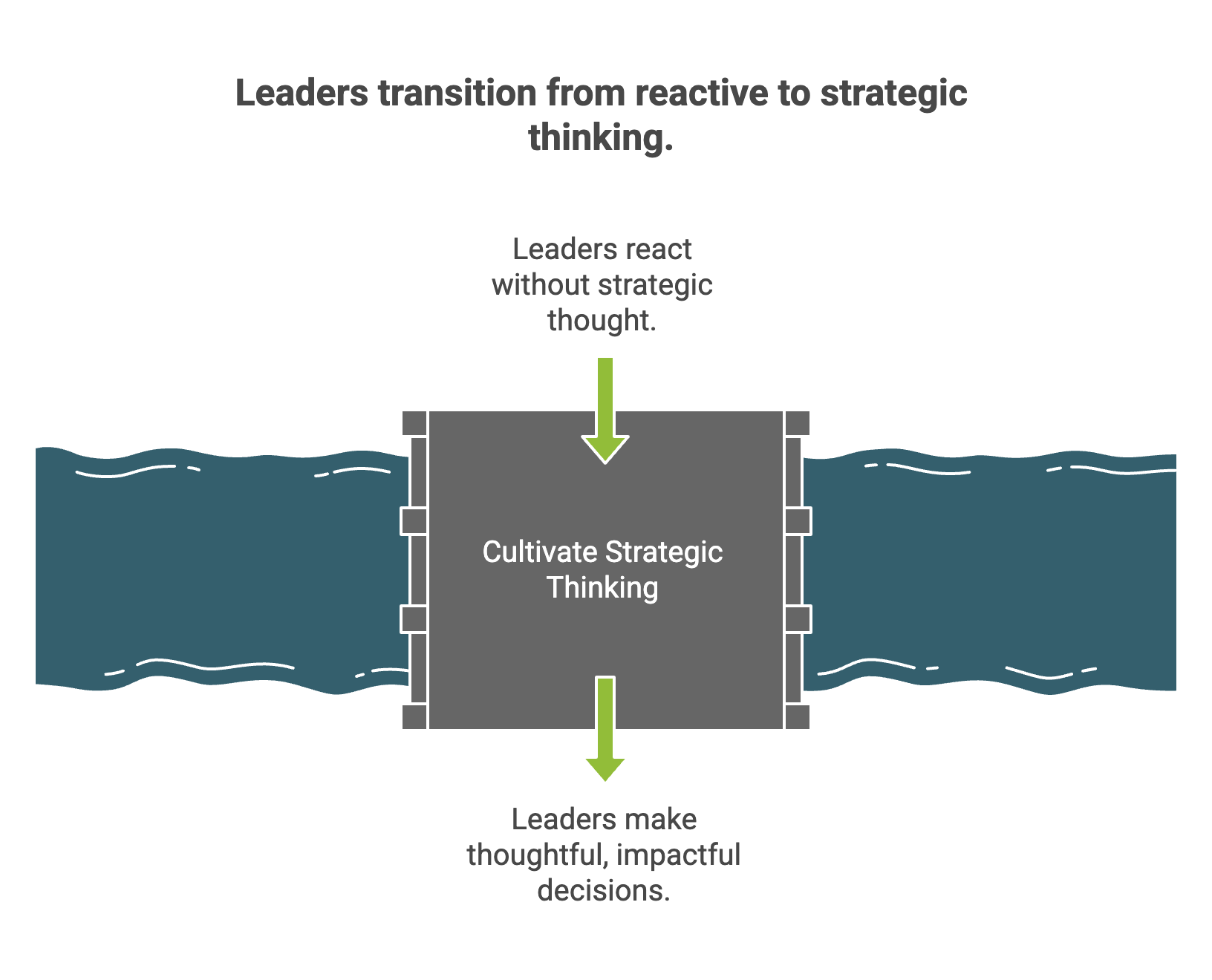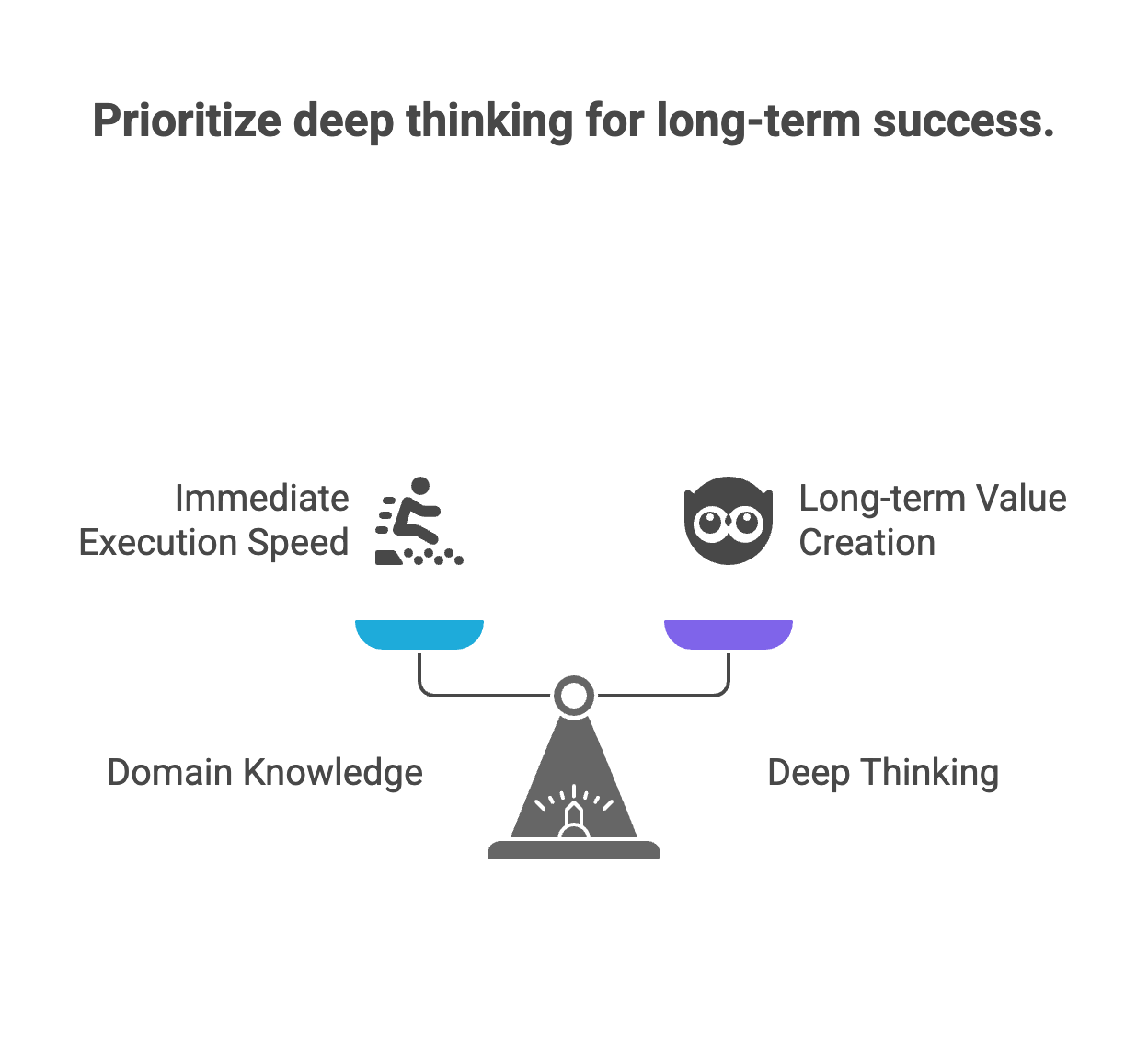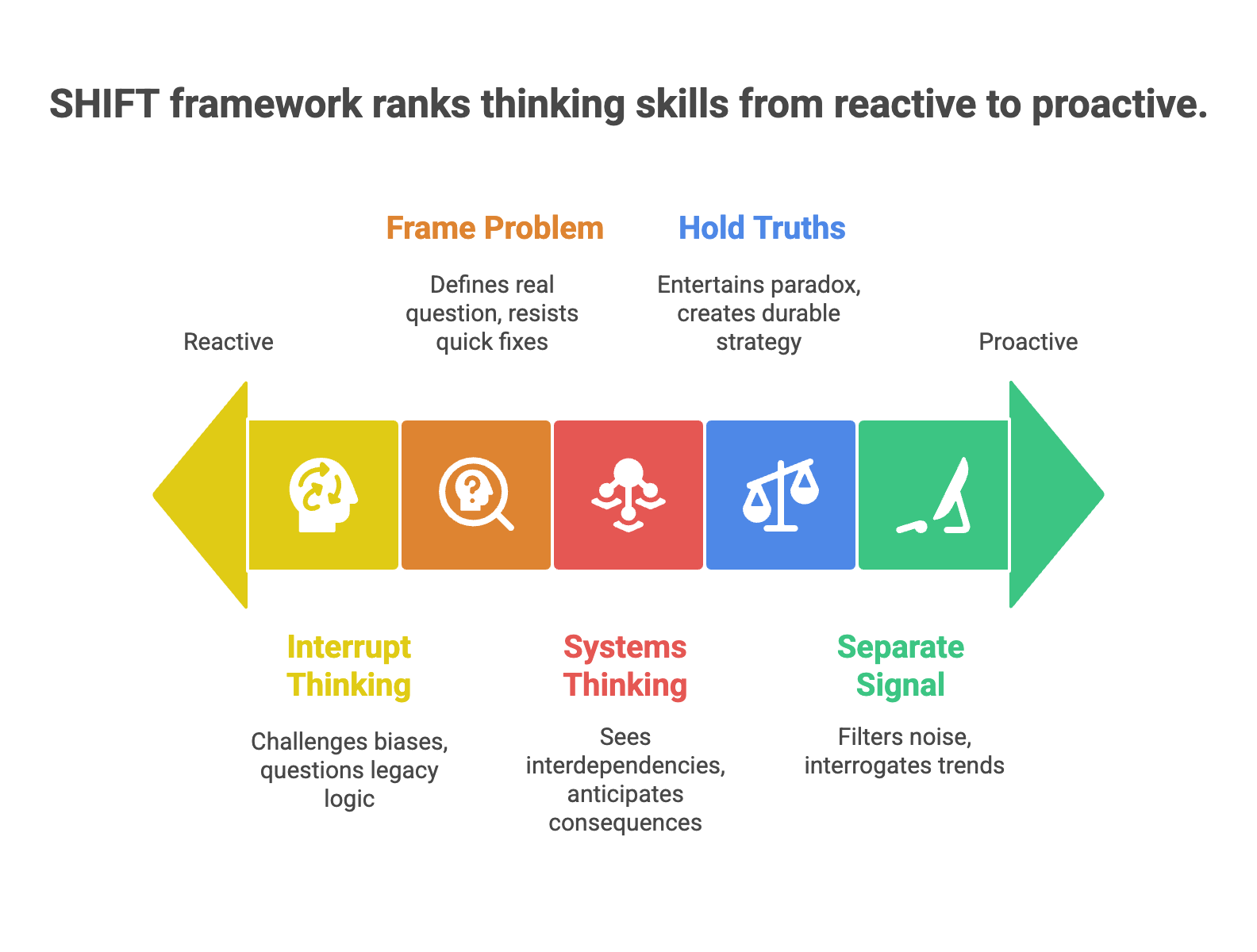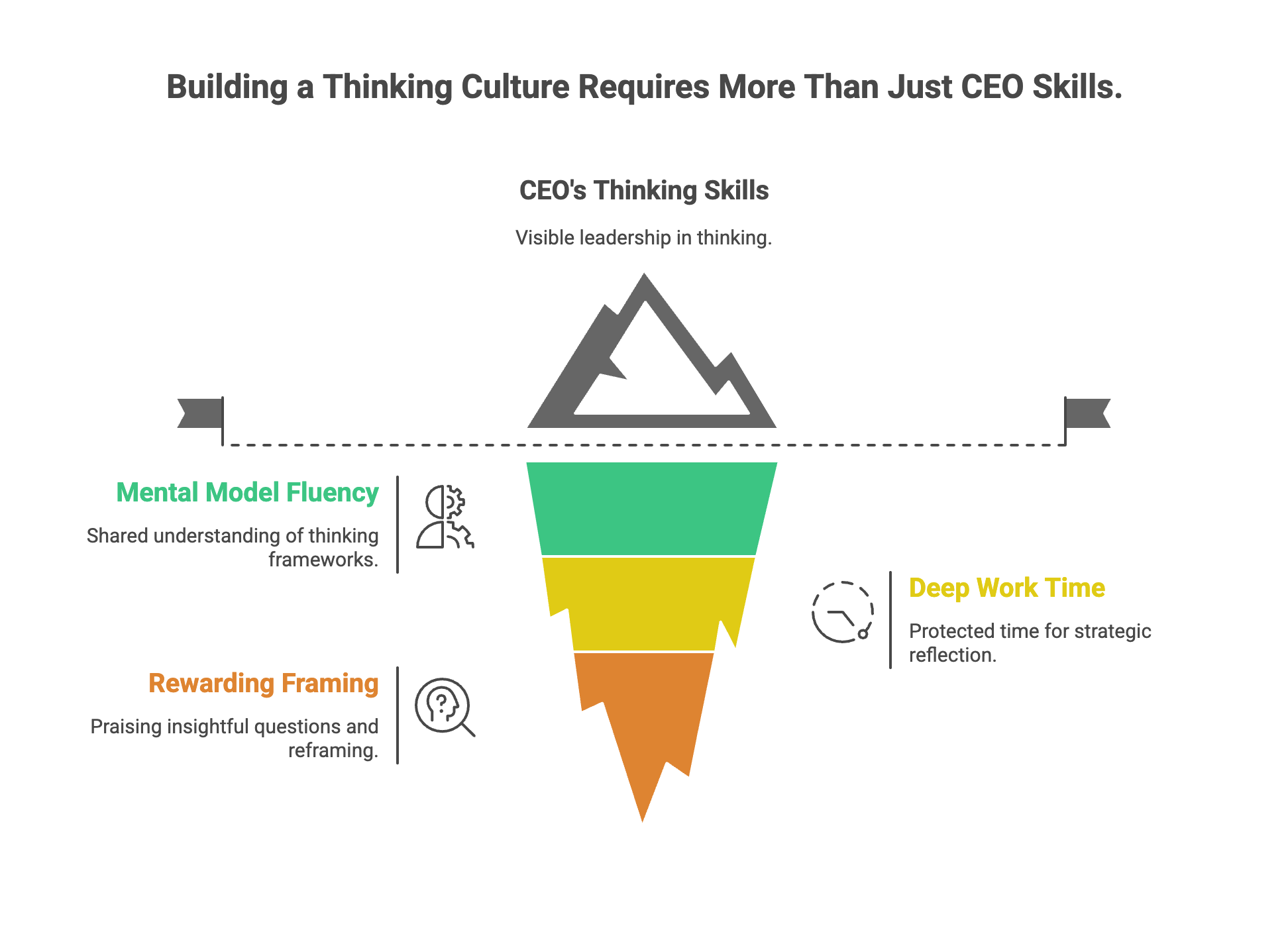Mental Model
July 24, 2025
6
Min
Why Thinking Skills Will Define the Next Generation of CEOs
Critical Thinking
|
Usually, it’s shorthand for something we can't quite measure: the ability to pause in chaos, question the obvious, choose the long view, or decide when not to decide. In short, it’s about thinking - not just reacting, analysing, or executing.
In an age of AI copilots and data-rich dashboards, this might sound counterintuitive. Isn’t thinking what machines are getting better at? Perhaps. But how we think - and how we teach others to think - is fast becoming the rarest and most strategic differentiator for senior leaders.
Especially CEOs.

In the coming decade, the complexity and velocity of business change will eclipse what most current leadership models were built to handle.
The next generation of CEOs will need to:
McKinsey, in a recent survey of CEO priorities, noted that “the differentiator isn’t domain knowledge or execution speed - it’s the CEO’s thinking time. Those who reserve more time for deep thinking outperform in long-term value creation.”
Put differently: The edge is not in what you know. It's in how you process, synthesise, and decide.

Here’s how we organise the most essential thinking muscles into what we call the SHIFT Framework:
The world is louder than ever. The skilled CEO filters it.
They don’t just scan for trends - they interrogate them. They can tell a real shift in customer behaviour from a quarterly anomaly.
Reflection prompt: In your current information diet, how much is insight versus distraction?
Micro-action: Block a 45-minute “Pattern Spotting” session weekly. Review inputs from across functions and ask: What’s emerging that we haven’t named yet?
Polarisation is tempting. The great CEO resists it.
They can entertain paradox: speed and depth, growth and resilience, employee voice and decisive leadership. This dialectical skill creates more durable strategy.
Enterprise example: One client CEO reframed their org’s remote work conflict as “freedom with intentional contact,” moving the team from stalemate to shared design.
Micro-action: Try “both/and” reframing in your next debate. Instead of choosing sides, explore what each side protects - and how both might co-exist.
Most of us don’t think. We just re-think.
CEOs face enormous pressure to be decisive. But if every strategic call is shaped by unexamined biases or legacy logic, they risk scaling the wrong idea faster.
Reflection prompt: What part of your leadership style runs on autopilot? Where did it come from?
Micro-action: Identify one “default belief” this week and ask your team to challenge it openly. Make this an invited ritual, not a threat.
Too many decisions solve the wrong problem.
Exceptional CEOs resist jumping straight into “fix mode.” They slow down to define the real question. What are we really trying to shift? Where’s the tension really showing up?
Pro Tip: The first formulation of a problem is rarely the most strategic one.
Micro-action: In your next big meeting, spend 10 minutes refining the framing question before offering a single solution.
The best CEOs see interdependencies, not functions.
They think across time horizons and feedback loops. They anticipate knock-on effects and unintended consequences. This is systems thinking - and it can’t be outsourced.
Example: When rethinking incentive structures, one CEO we worked with mapped out cultural, customer, and compliance impacts before proposing any change. What emerged was a triple-layered plan that built trust, not resistance.
Micro-action: Before your next policy or structural change, draw a systems map. What are the upstream and downstream effects across stakeholders?

The CEO’s thinking skills are just the tip. The wider impact comes when these skills infect the organisation.
Here’s how to start embedding them:

These traps often derail otherwise smart CEOs:
Where do I default to old playbooks when I should be questioning the rules?
Which thinking skill from the SHIFT model feels least developed in me right now - and why?
Block 15 minutes this Friday. Write freely. You may be surprised by what emerges.
This isn’t just a mindset shift. It creates tangible advantages:
Most importantly, a thinking-centred CEO helps teams think better too. And that ripples across every conversation, every project, every quarter.
Declare a “Thinking Half-Day.” Step away from ops. Block distractions. Bring one knotty issue. Frame it 3 ways. Draft a memo, not a slide.
Let others see you doing it. Model the priority. Thinking is a practice - not a talent.
We’d love to hear how you’re building this capacity in your organisation. What rituals, prompts, or provocations are helping your leaders think at a higher level?
Team SHIFT
What do we really mean when we say a leader has “good instincts”?
Usually, it’s shorthand for something we can't quite measure: the ability to pause in chaos, question the obvious, choose the long view, or decide when not to decide. In short, it’s about thinking - not just reacting, analysing, or executing.
In an age of AI copilots and data-rich dashboards, this might sound counterintuitive. Isn’t thinking what machines are getting better at? Perhaps. But how we think - and how we teach others to think - is fast becoming the rarest and most strategic differentiator for senior leaders.
Especially CEOs.

In the coming decade, the complexity and velocity of business change will eclipse what most current leadership models were built to handle.
The next generation of CEOs will need to:
McKinsey, in a recent survey of CEO priorities, noted that “the differentiator isn’t domain knowledge or execution speed - it’s the CEO’s thinking time. Those who reserve more time for deep thinking outperform in long-term value creation.”
Put differently: The edge is not in what you know. It's in how you process, synthesise, and decide.

Here’s how we organise the most essential thinking muscles into what we call the SHIFT Framework:
The world is louder than ever. The skilled CEO filters it.
They don’t just scan for trends - they interrogate them. They can tell a real shift in customer behaviour from a quarterly anomaly.
Reflection prompt: In your current information diet, how much is insight versus distraction?
Micro-action: Block a 45-minute “Pattern Spotting” session weekly. Review inputs from across functions and ask: What’s emerging that we haven’t named yet?
Polarisation is tempting. The great CEO resists it.
They can entertain paradox: speed and depth, growth and resilience, employee voice and decisive leadership. This dialectical skill creates more durable strategy.
Enterprise example: One client CEO reframed their org’s remote work conflict as “freedom with intentional contact,” moving the team from stalemate to shared design.
Micro-action: Try “both/and” reframing in your next debate. Instead of choosing sides, explore what each side protects - and how both might co-exist.
Most of us don’t think. We just re-think.
CEOs face enormous pressure to be decisive. But if every strategic call is shaped by unexamined biases or legacy logic, they risk scaling the wrong idea faster.
Reflection prompt: What part of your leadership style runs on autopilot? Where did it come from?
Micro-action: Identify one “default belief” this week and ask your team to challenge it openly. Make this an invited ritual, not a threat.
Too many decisions solve the wrong problem.
Exceptional CEOs resist jumping straight into “fix mode.” They slow down to define the real question. What are we really trying to shift? Where’s the tension really showing up?
Pro Tip: The first formulation of a problem is rarely the most strategic one.
Micro-action: In your next big meeting, spend 10 minutes refining the framing question before offering a single solution.
The best CEOs see interdependencies, not functions.
They think across time horizons and feedback loops. They anticipate knock-on effects and unintended consequences. This is systems thinking - and it can’t be outsourced.
Example: When rethinking incentive structures, one CEO we worked with mapped out cultural, customer, and compliance impacts before proposing any change. What emerged was a triple-layered plan that built trust, not resistance.
Micro-action: Before your next policy or structural change, draw a systems map. What are the upstream and downstream effects across stakeholders?

The CEO’s thinking skills are just the tip. The wider impact comes when these skills infect the organisation.
Here’s how to start embedding them:

These traps often derail otherwise smart CEOs:
Where do I default to old playbooks when I should be questioning the rules?
Which thinking skill from the SHIFT model feels least developed in me right now - and why?
Block 15 minutes this Friday. Write freely. You may be surprised by what emerges.
This isn’t just a mindset shift. It creates tangible advantages:
Most importantly, a thinking-centred CEO helps teams think better too. And that ripples across every conversation, every project, every quarter.
Declare a “Thinking Half-Day.” Step away from ops. Block distractions. Bring one knotty issue. Frame it 3 ways. Draft a memo, not a slide.
Let others see you doing it. Model the priority. Thinking is a practice - not a talent.
We’d love to hear how you’re building this capacity in your organisation. What rituals, prompts, or provocations are helping your leaders think at a higher level?
Team SHIFT
What do we really mean when we say a leader has “good instincts”?
Usually, it’s shorthand for something we can't quite measure: the ability to pause in chaos, question the obvious, choose the long view, or decide when not to decide. In short, it’s about thinking - not just reacting, analysing, or executing.
In an age of AI copilots and data-rich dashboards, this might sound counterintuitive. Isn’t thinking what machines are getting better at? Perhaps. But how we think - and how we teach others to think - is fast becoming the rarest and most strategic differentiator for senior leaders.
Especially CEOs.

In the coming decade, the complexity and velocity of business change will eclipse what most current leadership models were built to handle.
The next generation of CEOs will need to:
McKinsey, in a recent survey of CEO priorities, noted that “the differentiator isn’t domain knowledge or execution speed - it’s the CEO’s thinking time. Those who reserve more time for deep thinking outperform in long-term value creation.”
Put differently: The edge is not in what you know. It's in how you process, synthesise, and decide.

Here’s how we organise the most essential thinking muscles into what we call the SHIFT Framework:
The world is louder than ever. The skilled CEO filters it.
They don’t just scan for trends - they interrogate them. They can tell a real shift in customer behaviour from a quarterly anomaly.
Reflection prompt: In your current information diet, how much is insight versus distraction?
Micro-action: Block a 45-minute “Pattern Spotting” session weekly. Review inputs from across functions and ask: What’s emerging that we haven’t named yet?
Polarisation is tempting. The great CEO resists it.
They can entertain paradox: speed and depth, growth and resilience, employee voice and decisive leadership. This dialectical skill creates more durable strategy.
Enterprise example: One client CEO reframed their org’s remote work conflict as “freedom with intentional contact,” moving the team from stalemate to shared design.
Micro-action: Try “both/and” reframing in your next debate. Instead of choosing sides, explore what each side protects - and how both might co-exist.
Most of us don’t think. We just re-think.
CEOs face enormous pressure to be decisive. But if every strategic call is shaped by unexamined biases or legacy logic, they risk scaling the wrong idea faster.
Reflection prompt: What part of your leadership style runs on autopilot? Where did it come from?
Micro-action: Identify one “default belief” this week and ask your team to challenge it openly. Make this an invited ritual, not a threat.
Too many decisions solve the wrong problem.
Exceptional CEOs resist jumping straight into “fix mode.” They slow down to define the real question. What are we really trying to shift? Where’s the tension really showing up?
Pro Tip: The first formulation of a problem is rarely the most strategic one.
Micro-action: In your next big meeting, spend 10 minutes refining the framing question before offering a single solution.
The best CEOs see interdependencies, not functions.
They think across time horizons and feedback loops. They anticipate knock-on effects and unintended consequences. This is systems thinking - and it can’t be outsourced.
Example: When rethinking incentive structures, one CEO we worked with mapped out cultural, customer, and compliance impacts before proposing any change. What emerged was a triple-layered plan that built trust, not resistance.
Micro-action: Before your next policy or structural change, draw a systems map. What are the upstream and downstream effects across stakeholders?

The CEO’s thinking skills are just the tip. The wider impact comes when these skills infect the organisation.
Here’s how to start embedding them:

These traps often derail otherwise smart CEOs:
Where do I default to old playbooks when I should be questioning the rules?
Which thinking skill from the SHIFT model feels least developed in me right now - and why?
Block 15 minutes this Friday. Write freely. You may be surprised by what emerges.
This isn’t just a mindset shift. It creates tangible advantages:
Most importantly, a thinking-centred CEO helps teams think better too. And that ripples across every conversation, every project, every quarter.
Declare a “Thinking Half-Day.” Step away from ops. Block distractions. Bring one knotty issue. Frame it 3 ways. Draft a memo, not a slide.
Let others see you doing it. Model the priority. Thinking is a practice - not a talent.
We’d love to hear how you’re building this capacity in your organisation. What rituals, prompts, or provocations are helping your leaders think at a higher level?
Team SHIFT
